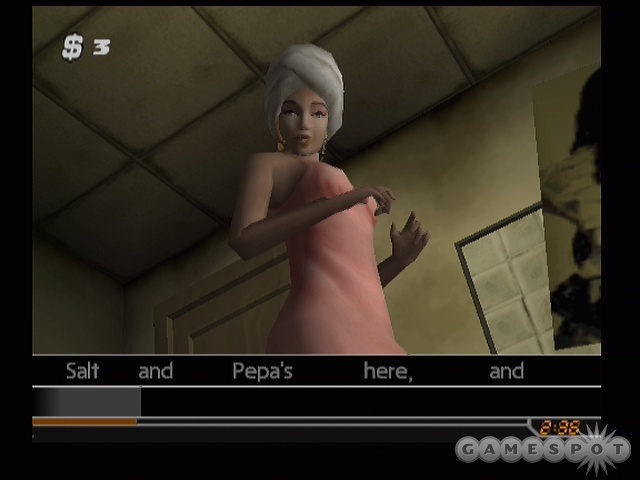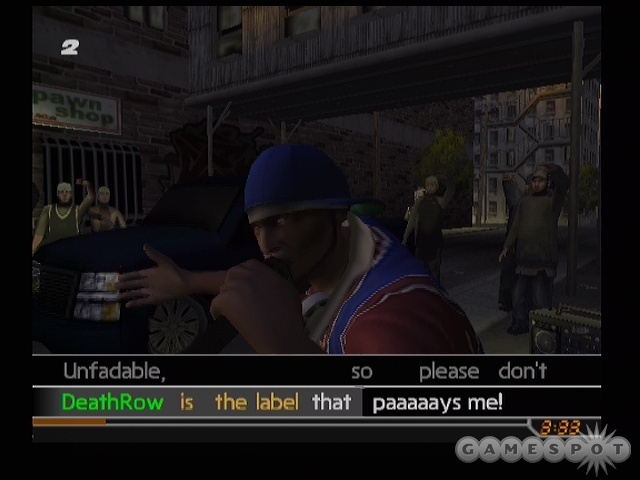With Konami's Karaoke Revolution series ignoring hip-hop completely, it seems like a perfectly natural progression for someone else to try to step in and fill the void. That's what Eidos and developer A2M have done with their new "rapaoke" game, Get On Da Mic. While the concept behind Get On Da Mic is a sound one, a series of design and technical flaws makes the game more frustrating than fun.

Get On Da Mic has a collection of 40 songs that span the history of hip-hop, going all the way back to the Sugarhill Gang's pioneering song "Rapper's Delight" and then shooting forward in time to include songs like Lil' Flip's "Game Over" and J-Kwon's "Tipsy." Other hits, such as "Posse on Broadway," "Nuthin' but a 'G' Thang," "Gin and Juice," "The Humpty Dance," "Push It," and "Hypnotize" are also included. Of course, in standard karaoke fashion, the songs aren't performed by the original artists. And that's where the game's first problem comes in.
Get On Da Mic judges your performance by how well you can fit your rapping to the rapping recorded in the song. Unfortunately, Get On Da Mic uses the rapping from the game's rerecorded songs, which are oftentimes different from the original recordings--going so far as to actually get some of the songs' words wrong. The game doesn't really judge what you're saying, because it can only detect your cadence. But when a song like NWA's "Express Yourself" actually inserts an extra word into one line, it's extremely disappointing, because the game essentially forces you to learn these new versions of its songs to succeed on the higher difficulty settings. On top of that, the decision-making that went into determining which lines were to be said by the player and which would be handled by the in-game backup lyricist is totally random. For example, when performing the "made famous by DMX" song, "X Gon' Give It To Ya," you don't get to perform the chorus, which is probably the best part of the entire song. Yet in "California Love," the game expects you to fill in every single "uh huh" and "yeah" at the end of the song, and you have to do it at the right moment, which is practically impossible if you don't already know when to come in.
Also on the disappointing side are the versions of the songs used as the bases for these new rerecordings. For the most part, censored album versions of the songs were used, but in a few cases--like with "Wit Dre Day," "X Gon' Give It To Ya, and "Gin and Juice"--the radio edits were used. Considering the game's lyricists simply don't say any of the objectionable words in the songs, and since the onscreen lyric display obscures curse words with pound signs, there's no real excuse for using any radio edits. Beyond that, it's a little strange to see this game receive a "T" rating and then basically ask you to decode obscured curse words such as "n#####," "motherf#####," and "d###."
Wait... "D###"? That's "dope" for those of you who couldn't figure it out. The game does its best to obscure any pro-drug references. However, its censorship isn't uniform in the least. It's also often incorrect. NWA's lone radio-friendly single, "Express Yourself," is the most blatant case of this. The line "Add it on a dope beat" has its reference to "dope" changed to "d###," even though the term in question doesn't have anything to do with drugs whatsoever. Meanwhile, later on in the song, the line "I don't smoke weed or cess" comes through loud and clear. In the Dr. Dre hit, "Next Episode," the part at the end of the song where you'd expect a faux Nate Dogg to croon "smoke weed every day" is cut entirely. Though some might find it admirable that the game makes a point to get across an antidrug message by blocking out all the pro-drug or pro-violence banter, the game's poor judgment calls and failures to recognize nondrug references--as opposed to urban, hip-hop "street" lingo--discredit and devalue Get On Da Mic. Moreover, in a game that requires you to already be very familiar with the subject matter at hand to effectively play, the songs here significantly differ from their originals, which further serves as the game's death knell.
Karaoke Revolution, with its scoring that's based mostly on your ability to sing in key and its easy-to-read scrolling lyrics, is fairly friendly to people who are trying to sing songs that they might not be familiar with. Get On Da Mic only devotes two lines on the screen to displaying lyrics, but it does so in such a way that it's impossible for anyone who isn't already innately familiar with the songs to follow along. A bar, as well as spacing between words, attempts to convey the lyrical flow of each song, and a moving color bar attempts to tell you when you're supposed to say each word. However, this system fails miserably. Words end up sneaking up on you, and if you don't already know how the words are supposed to be said, the moving bars don't help at all. The easiest of the game's three difficulty settings loosens things up a bit, but some sort of bouncing ball or other indicator that could break words down into their syllables would be a much better indication of what you're supposed to be saying--and when you're supposed to be saying it.
Get On Da Mic breaks down into a few different modes. The career mode takes you through several different locations, from rapping in front of a bathroom mirror, to a mixtape recording session, to your own world tour. The Wake Up Show's Sway narrates the career mode, and Shady Records' DJ Green Lantern appears in a few levels, but their contributions are ineffectual. You just need to perform the game's songs well to proceed through its levels. Along the way, you'll earn money that can be used to purchase custom items for your character. Exhibition mode just lets you pick a song to perform. Practice mode is the same thing but without the scoring. Freestyle mode lets you do whatever you want either over the game's 40 songs or over an additional 40 beats. In multiplayer freestyle mode, a player with the controller can judge your freestyle. The game also has EyeToy support, letting you replace the game's graphics with a video image, if you so desire.

Graphically, Get On Da Mic doesn't look so good. It doesn't seem like much attention was paid to the backgrounds in each different level. You can choose from a handful of different characters, all of whom have their own animation styles that play while they're rapping. The only problem is that the animations aren't synced up with the songs at all. So even in parts with no lyrics at all, you'll see your character wildly gesticulating as if he or she was spitting fire on the microphone. When you start to perform well, a meter will fill up, and a short "rock the mic" sequence will take place. There are a few different ones, including one that makes it snow and another one that makes money fall from the sky.
Get On Da Mic is a disappointment from top to bottom. The soundalike song performances are sketchy, the entire gameplay and lyric display systems are deeply flawed, and the decision-making that went into the editing and censoring of the game's songs is totally scattershot. Get On Da Mic is a neat idea that could have potentially filled a gap left by Karaoke Revolution's lack of hip-hop, but the problems that plague this game are too glaring to overlook. Stick to rapping along to these songs in your car.



